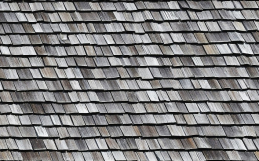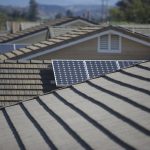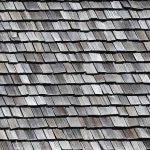Roof Plywood Repair: Your Ultimate Guide
Your roof is your home’s first line of defense against the elements, shielding you and yours from rain, wind, and harsh weather conditions. But what happens when a hole appears in your roof plywood, threatening the integrity of the roofing system? With the right tools, materials, and know-how–and reading this guide–you’ll know how to repair a hole in roof plywood.
But first, let us ask you something: should you? Roof plywood, also known as roof decking, is a crucial layer of the roof’s framework. It is installed on the roof joists, then covered in tar paper or synthetic underlayment, and provides a solid base for roofing materials, like composite shingles. Roof plywood also enhances the roof’s durability, supports insulation, and contributes to the overall integrity and longevity of the roof.
In order to properly repair the decking, you’ll need to remove the affected shingles and underlayment well beyond the hole to make sure you can get rid of the damaged plywood. This means getting on the roof, carefully pulling back shingles, and prepping the area around the hole so you don’t accidentally damage it more during repair.
Depending on the extent of the damage, it may be more than just a 16×16 inch area (16-inch centers are the traditional width) you’ll be fixing. Much more beyond that and a doable job grows exponentially. But let’s dive in and take a look at how to repair a hole in the roof plywood or decking.
Identifying the Damage
Before you can begin repairing a hole in your roof plywood, you need to identify the extent of the damage. Look for signs of water stains on your ceiling, sagging or soft spots on your roof, or visible holes or gaps in the plywood. These indicators can help you pinpoint the location and severity of the damage.
For definitive proof of damage, head up to the attic with a flashlight and carefully walk on the rafters if no flooring was put down. It will become pretty clear pretty quickly if you have issues with the roofing plywood and if you need a roof repair or even replacement. The plywood will be dark colored, there could be spores growing, and you may even see rivulets of water.
Once you’ve located the hole in your roof plywood, it’s time to assess the severity of the damage. Is the hole small and easily manageable, or is it larger and more extensive? Assessing the severity of the damage will help you determine the best course of action for repair. If whole panels need to be replaced, you’ll probably need a roof replacement.
Before you begin repairing a hole in your roof decking, follow these steps to ensure a smooth and safe repair process:
- Inspect the Damage: Assess the size and extent of the hole to determine the necessary repairs.
- Check for Additional Damage: Inspect the surrounding areas for water damage, mold, or rot, as these issues need to be addressed alongside the hole.
- Gather Tools and Materials: You’ll need safety gear (gloves, goggles, and a harness), replacement plywood, a saw, nails or screws, a hammer or drill, roofing felt, and shingles.
- Plan for Safety: Ensure a safe working environment by setting up a stable ladder, securing the area below, and considering the weather conditions.
A Note about Safety
As we well know, weather isn’t always predictable in the Pacific Northwest, and damage that requires repair doesn’t always happen when it’s clear and sunny out. Safety is paramount when working on a roof, especially on steep roofs. So remember a few safety measures:
Use Proper Safety Gear
Wear gloves, goggles, and non-slip shoes. Consider using a safety harness if working on a steep roof.
Stabilize the Ladder
Ensure the ladder is on stable ground and securely positioned.
Work in Good Weather
Avoid repairing the roof in wet or windy conditions to prevent accidents.
Secure the Area
Keep the work area clear of unnecessary tools and debris to avoid tripping hazards.
Instructions for Repairing the Hole
- Remove Damaged Shingles/Underlayment: Carefully remove shingles around the hole, preserving them for reinstallation or to get a count of replacement shingles you’ll need. With a knife, cut out damaged underlayment, leaving enough room to slide new underlayment underneath.
- Cut Out Damaged Plywood: Use a saw to cut out the damaged section of plywood, ensuring a clean, straight cut. To make sure you don’t cut into a joist, you will want to drill pilot holes from the attic if possible for a guide.
- Install Support Beams: Add support beams or braces around the hole to reinforce the structure and provide something solid to attach new plywood to. Make sure to inspect the existing joists as well to address damage (if any). If you are unsure about the extent of damage, it’s probably time to call in a professional like Warner Construction for an inspection.
- Install New Plywood: Cut a piece of replacement plywood to fit the hole. Secure it with nails or screws into the support beams you’ve installed.
- Reinstall Underlayment: Lay roofing felt over the repaired section, ensuring it fits under the existing underlayment. You may even want to put down proper roofer’s tape to seal where the new goes under the old for added protection.
- Replace Shingles: Reinstall the shingles, securing them properly to prevent leaks. Do this carefully because you don’t want to damage shingles that are already in place–and have to back down the ladder and up again with new shingles.
Avoid Simple Cover-Up
Simply covering the hole with another piece of plywood is not recommended. This approach can trap moisture, leading to rot and further damage. Properly remove and replace the damaged section to ensure a durable repair.
When to Consider a Partial Roof Replacement
If the damage is extensive or if multiple holes are present, it might be more practical to consider a partial roof replacement. If there is significant water damage and mold growth in multiple areas, large sections of rotted or compromised decking, or if your roof is nearing the end of its lifespan, it might be time to call Warner Roofing & Construction.







